Last fall, I learned about this relatively new small software development company located in Budapest (Hungary, European Union). Their goal is to create innovative graphic applications and make them accessible to a wide audience by keeping their usage simple and their price affordable. PostworkShop Pro was made public about a year ago. Since version 2 was on the horizon, I decided to wait until it was available since it had many new and improved features. Version 2 comes in 64 bit mode as well as 32 bit mode and as a plugin to Photoshop CS5 and other image editing programs. It is now June of 2011 and I am reviewing the final version of 2.
I am always excited to learn about new small developing companies. PostworkShop comes in three flavors: Basic Edition - which is free, an Artist Edition for $49.00, and a Pro Edition for $99.00.
What can you do with PostworkShop? As the name implies, you use it on a "completed" photograph or an image (layers in the original image are permissible) to change its character, look, and feel. I created a basic image in E-on Software's Vue 9 Infinite. I decided to use this rendered image as a base and go for different styles such as pencil, watercolor, etc. One of the major ways this program radically differs from other programs that allow the user to create various image styles is that you can combine different styles in layers and use the same type of blending and layer opacity options that you find in Photoshop. This adds a tremendous amount of flexibility. Also, you can create your own styles through nodes. I will explain all of this as I continue with the review. Xycod's PostworkShop website has all the instruments for quickly learning PostworkShop Pro as well as developing your skills. Even with the excellent tutorials and forum, a searchable manual would be very useful. Below are some useful links from the website.
Looking at their gallery is very informative because you can see by category so many various types of results.
Before we start, listed below are some of the new features in version 2.
New Features:
Only in the Professional edition
- PostworkShop works in plug-in mode
- 64 bit program version
- Unlimited render size (depends on the available memory)
- Batch improvements (regular expression based naming, displaying rendered images, persistent settings)
In the Artist and Pro editions
- Manual paint/retouch/clone module
- Alpha Map (layer mask) editor
- Auto save custom styles in the Style History
- Simplified Save Style window (publishing is not necessary any more)
Available in all editions
- New styles, textures and brushes
- Multi-language user interface
- Toolbar (faster save, layout switching, ...)
- Detachable Projects/Styles/Properties panels
- DPI management (canvas and images)
- Image properties (pixel/physical size, DPI) displayed
- Image Resize window (pixel/physical size, DPI)
- New Save window (for projects and images)
- Objects/Layers can be renamed
- Pin types are displayed on the style thumbnails
- New Color Selector modes (Color Wheel, Color Names)
- Categorized, visual texture selector
- Categories in the brush selector
- Easier selection of active brush family members
- Data folder can be displayed from the application
- Optional automatic "Check for Updates" functionality
Bug fixes:
- File format issues
- Imported ABR brush inversion
- Image copy/paste on Mac
- Resizable application window on Mac
- Data Execution Prevention (DEP) issue on Windows
To test PostworkShop Pro, I ran it through the same paces that I do similar programs of which there are a few that allow the user to use and create styles. I work for print as well as the web. One criteria that is important to me is to be able to use images that will be large enough to carry detail should I print them as I do using 13" x 19 " paper. I loaded flat files as well as files with layers. The first image was about 10" x 7" at 240 dpi or 2400 x 1763. The size was about 53 MB because of the layers.

Notice how you can change the properties in the right panel.

You can work two ways in PostworkShop Pro. You can use styles and layer them and change their parameters
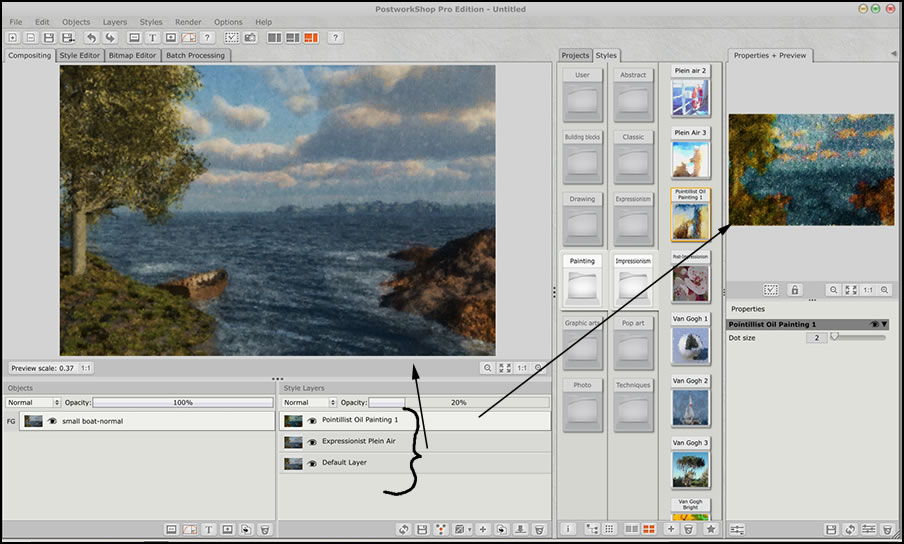
and/or you can create your own styles with your own parameters. Notice how the Compositing and Style Editing reflect each other.
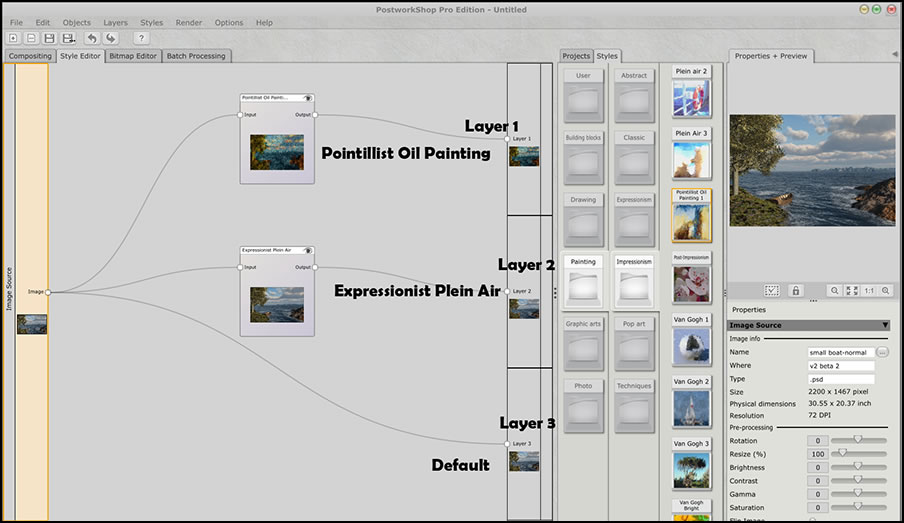

I thought I would show how using different layer configurations look in both the Style Editor and the Compositing View. On the left, the two styles and the original image are one layer. On the right side, each style and the original are on separate layers.

An interesting feature is the Alpha Editor where you can create alpha masks to change the style of parts of your image. It is very easy to use and has a tutorial with it. While this tutorial is from the PostworkShop website, I am including a link to it in the body of the review.
The first screen capture shows the masking of the quay so the background default image shows through.
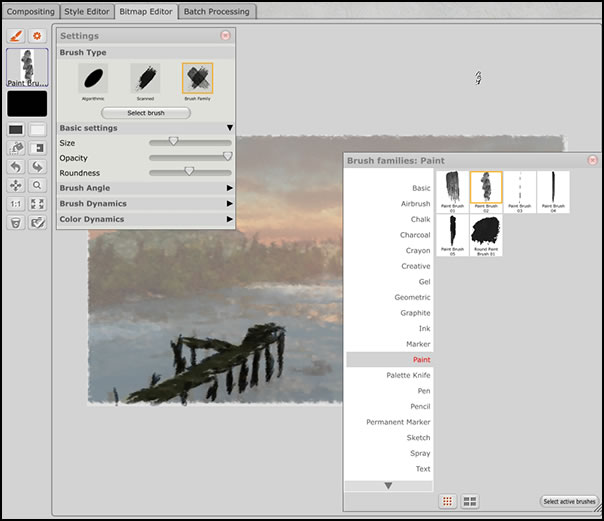
The next screen capture shows how the default layer shows through the mask.
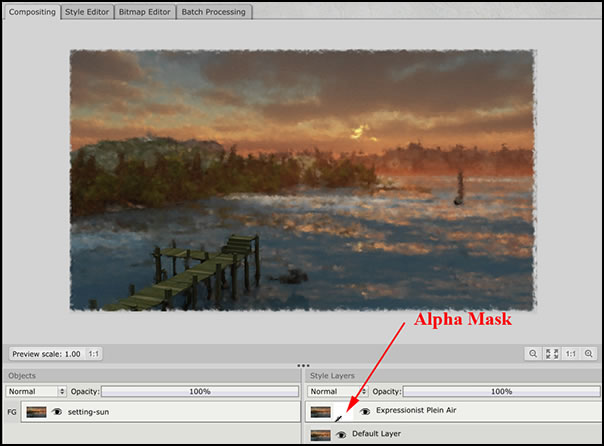
Here is an easy way to modify the image showing through the mask. You can create a mask that is not 100% black or white which gives you the ability to make changes later.
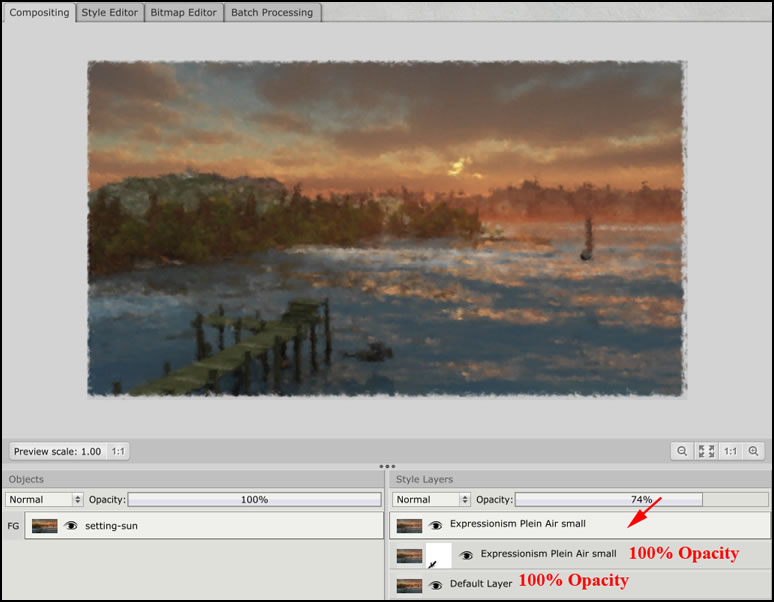
Another hint: If you use a lot of alpha channels in Photoshop, delete them before bringing the file into the standalone version of PostworkShop Pro. (I am not referring to creating Alpha Masks in PostworkShop Pro.)
Having had the various betas on my machine, I installed this final version over them. I did make sure that the plugins from former versions did not remain. I installed both the 32-bit version and the 64-bit version. Adobe Photoshop CS5 64-bit installed the plugin perfectly. However, while the PostworkShop Pro plugin for Photoshop CS5 32-bit did install, I could not find it on Photoshop's filters' menu.
The more I use PostworkShop Pro, the more tricks I picked up to customize and modify an image. I really enjoy the flexibility and stability of this new version. If you liked version 1, you should love version 2. Working with large files in version 2 is as easy as working with small ones. For me that was important. The improvements in version 2 are numerous as are the new features and enhancements. This program is fun and easy to use with excellent results.
Requirements:
|
|
For a comparison between the various editions, click here. For more information go to PostworkShop's website.